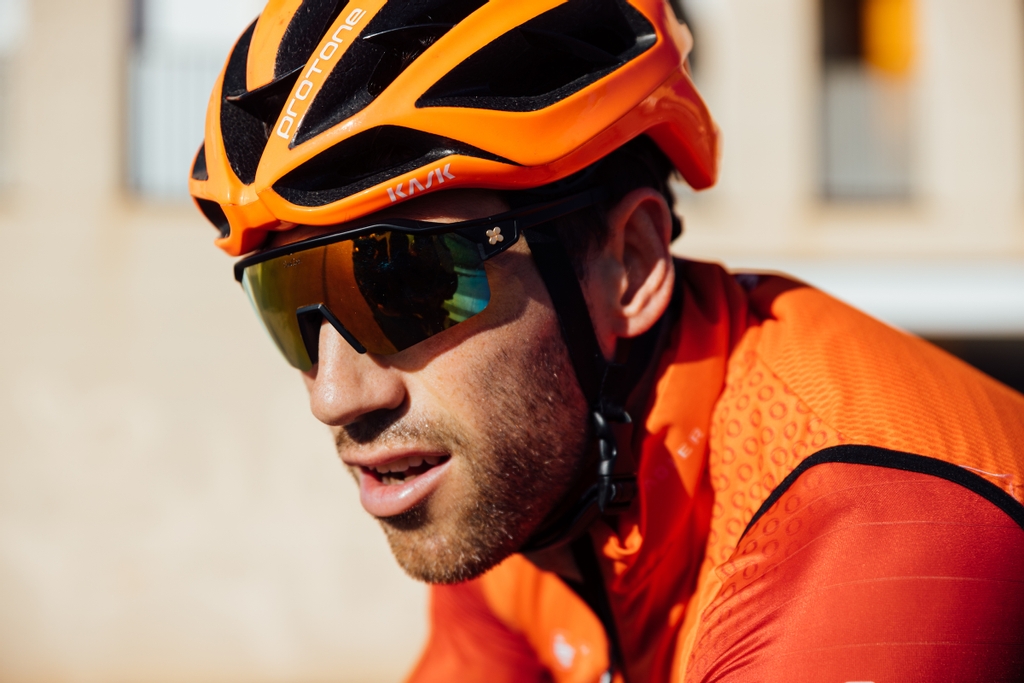Continuity is something that all teams of the Louis Vuitton 37th America’s Cup crave amongst their crew-members so, for INEOS Britannia, one of the very first confirmed hires was the outstanding athletic and sailing talent of Matt Gotrel. One of the most popular people not just within the INEOS Britannia set-up but also in the wider America’s Cup and sailing communities, Matt’s pathway through to the elite level was mapped out from an early age.
Having come through the famous and storied Royal Yachting Association Olympic Development Squad, where he was something of an ace in the 49er class, Matt’s decision to go to the University of Loughborough, where he studied Systems Engineering, saw him switch athletic disciplines and take up the sport of rowing. His natural physical attributes lent perfectly to the sport plus his dedication to training marked him out as something special.
In 2013 and 2015, Matt was part of the Men’s Eight that won gold at the World Championships, but the pinnacle was being selected for the Rio 2016 Olympic Games and joining a team that had won silver and bronze at Beijing 2008 and London 2012 and were desperate to climb the podium. Matt was the key and getting through to the final, they were top seeds, going on to dominate the medal race, never being led, to win an outstanding Gold Medal that was heralded throughout the sport, and naturally the Royal honour of an MBE followed.
When INEOS Britannia was recruiting for grinding talent for their Auckland 2021 Challenge, Matt Gotrel’s name was high on the list and he joined the team, determined to push on and win sailing’s ultimate prize. Now a key member of the British cyclor squad, Matt is looking forward to racing at the upcoming Preliminary Regatta that starts on the 22nd August ahead of the Louis Vuitton Cup on the 29th August.
Talking about the switch from grinding with the arms to cycling onboard the AC75, Matt sees similarities.
“In terms of training, it’s all very similar, you are just trying to train your body to use a different muscle group, so your levels of fitness and endurance are still there, you just have to try and retrain your muscles to do it again. Hopefully we’ve had enough time now to switch over, we’ve spent a lot of hours training and putting the hours in over the winter has been really important, so hopefully we’ll peak at the right time and get ready for racing in a few weeks’ time.
“I guess like any sport it’s always pretty similar in terms of training, the needs as a racer are fairly similar, it’s an endurance sport, the biggest change for us has been switching from arms to legs from last time but the demands of the boat and the demands of the racing are very similar.
“Although we’ve got a bigger muscle group, using our legs, we’ve lost two people’s power from the arms so essentially, it’s a flat-out effort with spikes around the course so it’s very dynamic, but the training is slightly different with longer hours on the cycling side of things. Now as the racing is getting closer, we’re just sharpening up the tools and focussing on the shore stuff.”
As elite athletes, the demands on the cyclor teams is intense the INEOS Britannia team are keeping a close watch on how they deal with the heat and strain of sailing the AC75s at such high levels of physical endurance.
“Heat is definitely a big thing and a big worry for us as we know it can be a big hit and effect on your power output,” Matt confirms. “So lots of ice vests, trying to keep the body as cool as possible before and after you get on the yacht as, once you are on there, there’s not a lot you can do about it, you’re in a little carbon box and it gets pretty hot but we’re doing all we can to try and make sure we’re keeping as cool as possible around the sailing.”
The endurance demands are high as Matt further describes, saying: “I guess a hot day on the water you can be out there for four or five hours, and irrelevant of whether you’re exercising or not you’re still going to be sweating and burning a lot of calories so you need to consume at least 4-5 litres when you’re out there and it disappears pretty quick so we keep an eye on our weight before and after sailing and you’re just trying to make sure you replenish what you’ve lost and hopefully don’t get into any deficits – that would be the biggest issue as over a two week racing period you have got to make sure you are ready to go the next day as well and not just treat it as a one day race.”
With aero considerations to factor in, the cyclor role is largely heads-down concentrating on the power delivery. Matt describes it with a chuckle, saying: “When you look at it from the outside it’s pretty uninspiring to be a cyclor – you’re head down looking at the floor or the display and it’s very hard to know exactly what’s going on.
‘I guess having a sailing background and having done the America’s Cup before you listen to the comms from the afterguard and the guys at the back of the boat so you kind of switch onto that and have a rough idea of where the other boats are and what going on but you’re not sticking your head up to have a look that’s for sure. So, it’s a very different look for us but I think you just focus on your job and the race slides by pretty quick, and you just watch it back on TV if you really want to figure out what’s happening!”
The power-hungry AC75s constantly demand input from the four-man cyclor team and it’s tough work as Matt confirms: “You are always pedalling, you’re always putting power into the boat and ultimately the boat will take all the power you can throw at it so you have to be quite tactical as in how and when you use the power and that’s part of the skill of the system, making it as efficient as possible and then just learning the boat and how we race it and trying to maximise moments when you need to put big power in and then trying to realise when you can recover, but essentially it’s a hot, sweaty, hard race, that’s what we’ve trained for and that’s what we’re looking forward to.”
So, what is it really like sailing onboard the fastest monohulls in the world at speeds that were unimaginable even ten or twenty years ago, and being tasked with the power delivery? Matt doesn’t sugar-coat it, saying: “It’s definitely a big challenge and something you can’t really explain or prepare for, you can do all the training on the road or in the gym and that’s where you can do your controlled stuff, and you can focus on the numbers and recovery, and it feels quite nice I guess while you’re on a bike indoors. But then you jump on a boat and suddenly you’re driving into a hydraulic pump which doesn’t feel like anything you can replicate on the land, you’re in a boat that’s flying out of the water and going round corners and it’s definitely not a stable platform.
“You can’t really do much on land, you can do what you can to get your fitness levels up, but the best preparation you can do is to go sailing and we’ve done a lot of that recently which has been good and preparing for the race. Once we got our hands on the new AC75, it was really important for us to learn as quickly as possible and it’s a tough feeling when you come off the water as you feel beaten and bruised and it’s really important to try and recover again so you’re fresh to go the next day.
“I guess it’s one of those roles, we’re kind of the ‘Sherpas’ plugging away in the background, but it’s amazing to be part of this and be on those boats out there flying around and when you do get a chance to have a look at what’s actually going on, look back at the photos and realise that you’re providing the power to this amazing machine is pretty special.”
As an elite athlete, Matt knows all about giving the maximum effort in everything he does and switching from grinding to cycling has been a welcome change but no less demanding as he explains: “It’s nice to have a change from being grinding for so long. To jump back to cycling was quite nice, to be able to go out riding your bike and stop at a few cafes which is a bit more sociable than just sitting in the gym training. I guess on the flip side of that, last time we were grinding into winches and doing more manual sailing which traditionally as a sailor is what you’re used to, so there’s pros and cons to both but the most important thing is to enjoy the challenge, give it your all, you enjoy it more when you’re winning so I’m sure, come October, that will be the plan!”
INEOS Britannia’s cyclor team are very much at the top of their game and look to be peaking at the right time. Power delivery is everything and the British certainly have put together a team more than capable of meeting and exceeding the demands of their powerful AC75. The ‘Sherpas’ of the Louis Vuitton 37th America’s Cup are primed and ready to deliver on the greatest stage of them all – you can’t win the America’s Cup without them.
(Magnus Wheatley)















